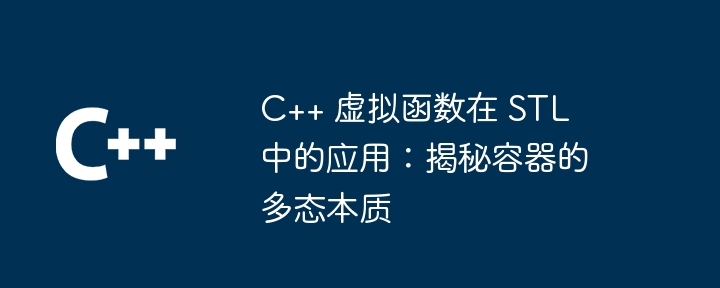
STL containers use virtual functions to achieve polymorphism, allowing base class pointers to call derived class methods. Specific applications include destructors and operating member functions, such as operator[], push_back(), and erase(), to achieve dynamic binding and storage of different types of objects.

The application of C virtual functions in STL: revealing the polymorphic nature of containers
Preface
STL (Standard Template Library) is a powerful container library in C, which provides us with various data structures and algorithms. In STL, virtual functions are widely used to achieve dynamic polymorphism of containers. This article will delve into the application of virtual functions in STL and demonstrate its role through practical cases.
Introduction to virtual functions
Virtual functions are a polymorphic feature in C that allow objects of derived classes to call their own through pointers or references of base classes Method of implementation. This means that a derived class object can behave like its base class object and be treated as a base class object.
Application of virtual functions in STL
Containers in STL, such as vector, list and map, all use virtual functions to achieve their polymorphism. Specifically, they declare virtual functions in the destructor and some operating member functions, such as operator[], push_back(), erase(), etc.
Practical case: dynamic binding and derived class container
In order to demonstrate the role of virtual functions in STL, we create a base class named Base, and two Derived1 and Derived2 are derived classes.
class Base {
public:
virtual ~Base() { };
virtual void print() const { cout << "Base" << endl; };
};
class Derived1 : public Base {
public:
virtual void print() const override { cout << "Derived1" << endl; };
};
class Derived2 : public Base {
public:
virtual void print() const override { cout << "Derived2" << endl; };
};Next, we create a vector
vector<Base*> vec; vec.push_back(new Base()); vec.push_back(new Derived1()); vec.push_back(new Derived2());
Now, let’s iterate through the vector and call the print() method of each object. Due to the use of dynamic binding, the base class pointer can automatically call the method of the derived class object to print the object's type in a polymorphic manner.
for (Base* obj : vec) {
obj->print();
}Output:
Base Derived1 Derived2
As you can see from the output, the print() method is called correctly and the type of the derived class is printed. This demonstrates how virtual functions implement container polymorphism in STL.
Conclusion
Virtual functions are the key mechanism to achieve container polymorphism in STL. STL containers can dynamically store and manipulate objects of different types by allowing base class pointers to call derived class methods. This polymorphism makes STL very powerful in developing scalable and maintainable code.
The above is the detailed content of The application of C++ virtual functions in STL: revealing the polymorphic nature of containers. For more information, please follow other related articles on the PHP Chinese website!
 What are the differences between c++ and c language
What are the differences between c++ and c language
 Recommended learning order for c++ and python
Recommended learning order for c++ and python
 Cost-effectiveness analysis of learning python and c++
Cost-effectiveness analysis of learning python and c++
 Is c language the same as c++?
Is c language the same as c++?
 Which is better to learn first, c language or c++?
Which is better to learn first, c language or c++?
 The difference and connection between c language and c++
The difference and connection between c language and c++
 C++ software Chinese change tutorial
C++ software Chinese change tutorial
 Cost-effectiveness analysis of learning python, java and c++
Cost-effectiveness analysis of learning python, java and c++




